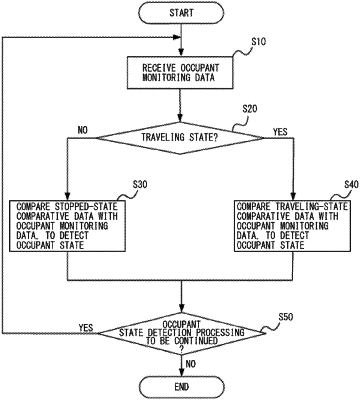| CPC H04N 7/18 (2013.01) [G06V 20/59 (2022.01); G07C 5/02 (2013.01)] | 6 Claims |

|
1. An occupant state detection system comprising:
an occupant monitoring apparatus configured to monitor a physical state of an occupant in a vehicle;
a determination apparatus configured to determine whether the vehicle is in a traveling state or a stopped state; and
an occupant state detection apparatus configured to detect a state of the occupant in the vehicle on a basis of occupant monitoring data from the occupant monitoring apparatus, wherein
the occupant state detection apparatus includes
one or more processors, and
one or more memories configured to be communicably coupled to the one or more processors,
the one or more memories are configured to store 1) first reference data that is behavioral criteria for determining behavior of the occupant, and 2) second reference data that is biological criteria for determining an abnormality in a body of the occupant,
the first reference data differs from the second reference data,
the one or more processors are configured to cooperate with one or more programs included in the one or more memories to
while the vehicle is in the traveling state, compare the occupant monitoring data with the first reference data, and determine the behavior of the occupant based on comparing the occupant monitoring data with the first reference data, and
when detecting that the vehicle is in the stopped state, switch criteria for determining the behavior of the occupant from the first reference data to the second reference data, compare the occupant monitoring data with the second reference data, and determine an abnormality in the body of the occupant based on comparing the occupant monitoring data with the second reference data.
|